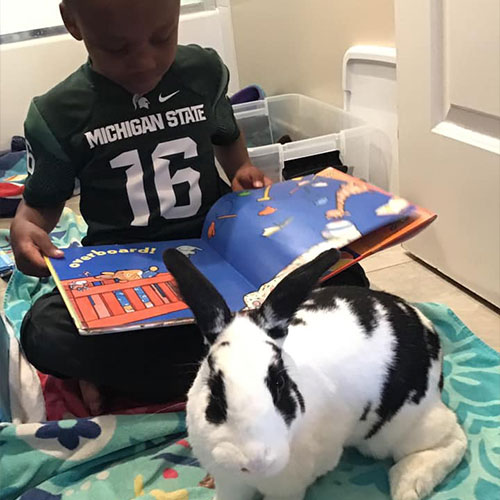For rabbits and small children, the bigger the rabbit, the better.
Big rabbits are less likely to be picked up or mishandled by little kids.
Large rabbits seem less like a toy and generally command more respect from kids.
Can rabbits and children get along? Yes—but there are several things to consider…
Many people are surprised and then disappointed to learn that rabbits rarely conform to the cute-n-cuddly stereotypes in children’s stories. While rabbits enjoy being stroked, most of them prefer to receive their attention while remaining on the ground or while sitting beside their person. As prey animals, rabbits instinctually feel frightened when picked up. As a result, they can kick and struggle, which can result in hurting themselves or even the child holding them.
Most children want a pet they can hold and cuddle. Rabbits need someone who understands they are ground-loving creatures and has the patience to let the rabbit come to them. For these reasons, many children, especially young children, find it a challenge to interact with a rabbit and may lose interest after a few weeks.

A Great Family Pet…for Some
While rabbits are not an ideal child’s pet, they can make a wonderful family pet–for the right family. An adult needs to be the primary caregiver, the one who is responsible for making certain the rabbit is fed, cared for, played with, and gently loved every day. Following this example, a rabbit can be a terrific part of a child’s life. Also, a family can grow over time. By being shown how, a new people baby can grow into their relationship with the rabbit, along with the rest of their family.
On the other hand, the natural exuberance, rambunctiousness, and decibel-level of the average toddler can also be stressful for some rabbits. Bunnies are naturally inclined to either run away or try to bite when approached too quickly and too loudly. A frequently stressed-out rabbit is more prone to develop illnesses.
However even toddlers can be supervised and taught to respect the rabbit and when to approach. For these little kids, teaching them how to pet a rabbit by using the back of the hand is a good way to get around their natural inclination to “pat” or tug the bunny.

Just like Rabbits, Kids Have Different Personalities, Too
If your child is generally easygoing, calm, gentle, and cooperative, your family may enjoy living with a rabbit. Kids who enjoy learning about animals and love watching how animals act, may have the patience to take the time to build a relationship with the rabbit.
If your child is generally very active, tends to interact physically or aggressively, or frequently needs reminders about rules, they may find it difficult to build a trusting relationship with a rabbit. In those instances, your family may find a rabbit is an additional stress for everyone involved. This is when a toy rabbit may be more appropriate.
For additional information about rabbits and kids, you can click the magnifying glass icon on the top right of the site and search for “kids”.

Sign up to Our Newsletter!
Sign up for web update alerts and our monthly e-newsletter
to stay current on HRS, our Chapters, and info for your bunny.




